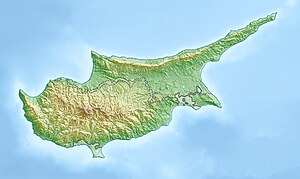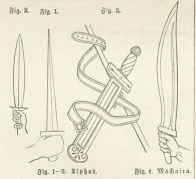
Nicosia, also known as Lefkosia and Lefkoşa, is the capital and largest city of Cyprus. It is the southeasternmost of all EU member states' capital cities.
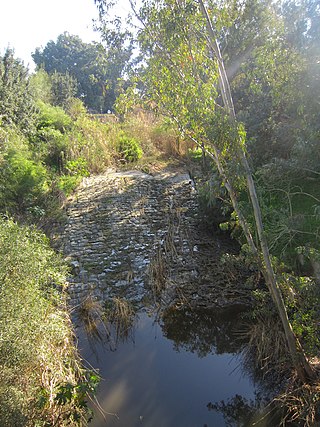
The Pedieos is the longest river in Cyprus. The river originates in the Troodos Mountains close to Machairas Monastery and flows northeast across the Mesaoria plains, through the capital city Nicosia. It then steers east, meeting the sea at Famagusta Bay close to the ancient Greek city of Salamis. Maximum depth is 10 meters.

Engomi is a suburb and municipality of the Cypriot capital Nicosia. In 2011, it had a population of 18,010. Of these, 14,254 were Cypriot citizens.

Galata is a village in the Solea valley, located about 60 km west of the capital Nicosia, at an altitude of 620 m in the Troodos Mountains of Cyprus. It is a popular summer tourist destination for its cooler climate in the summer months. It is also well known on the island for its fruit produce. In Galata there is Panagia tis Podithou, church, which was designated a UNESCO World Heritage Site in 1985 along with nine other Painted Churches in the Troödos Region, because of their unique murals and testimony to the history of Byzantine rule in Cyprus.
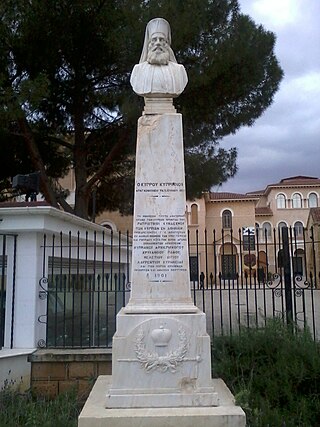
Archbishop Kyprianos of Cyprus was the head of the Cypriot Orthodox Church in the early 19th century at the time that the Greek War of Independence broke out.
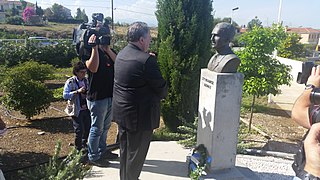
Stylianos Lenas was a member of EOKA, and one of the Cypriots who were wounded in battle against British soldiers.

Chandria is a village in Cyprus in the Limassol administrative district and belongs to the Pitsilia group of villages. At an elevation of 1,275 m (4,180 ft), it is the second highest village in Cyprus after Prodromos.

Agros is a village built on the Troödos Mountains, in the region of Pitsilia, in southwest Cyprus, which has built amphitheatrically among high mountains at an altitude of 1100 metres with a population of approximately 1,000. The village is located 45 minutes away from the cities of Nicosia and Limassol, 20 minutes from Troodos Square and 80 minutes from the international airports of Larnaca and Paphos.
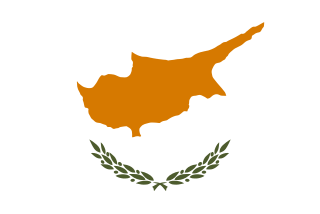
The following outline is provided as an overview of and topical guide to Cyprus:
Myrtou is a town in the Kyrenia District of Cyprus, north of the city of Morphou. It is under the de facto control of Northern Cyprus.

Klirou is a Historic Mining District and covers an area of 18.7 square kilometers. Klirou residents are known for their wealth and political influence. Situated in the northern foothills of the Troodos Mountains, 26 km southwest of Nicosia. The area was inhabited from the Late Bronze Age, by Arcadocypriot Greek settlers

Agios Epifanios is a village in the Nicosia District of Cyprus, located 5 km southwest of Klirou.
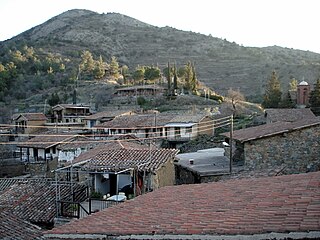
Fikardou is an old settlement that has retained its traditional medieval characteristics. It is situated on the south eastern slopes of the Troodos Mountains, approximately 40 km southwest of Nicosia. The village today is almost deserted. It's connected by two roads, one from Klirou and the other of Kalo Chorio Klirou. Nearby are also the traditional Lazanias village and the Machairas Monastery. The village is owned by the Department of Antiquities, which in 1978 has been declared as a World Heritage Site.
Fterikoudi is a village in the Nicosia District of Cyprus, located 4 km north of Palaichori Morphou.
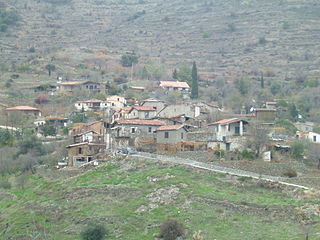
Lazanias is a village in the Nicosia District of Cyprus, located southwest of Gourri.
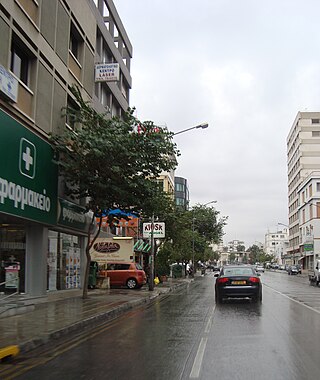
Pallouriotissa is an area of Nicosia, Cyprus, formerly an independent village, which was annexed to the municipality in 1968. It was subsequently divided into the quarters of Panayia (Panagia) and Saints Constantine and Helen. As of 2011, their combined population was 15,607. Pallouriotissa is immediately south of Kaimakli.
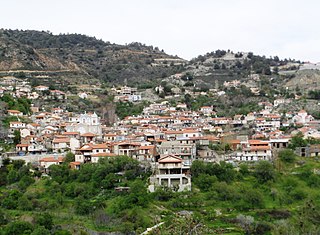
Pelendri is a village in the Limassol District of Cyprus.
Neophytos of Cyprus, Saint Neophytos, Neophytos the Recluse was a Cypriot Orthodox monk, priest, and sometime hermit, whose writings preserved a history of the early crusades. "He is considered to be one of the most significant figures of the Church of Cyprus"

Pitsilia is an agricultural region in Cyprus, with total area of 61,000 hectares, in a mountainous area of rocky land on very steep slopes that have been used mainly for grazing goats and sheep and for producing small amounts of cereals, wine and grapes. The region complemented by eastern, north and south eastern part of the Troodos Mountains at elevations between 500 and 1,600 metres and includes villages from the districts of Limassol and Nicosia.

The Archeparchy of Cyprus is a seat of the Maronite Church immediately subject to the Holy See. It is currently ruled by Archeparch Selim Jean Sfeir.

